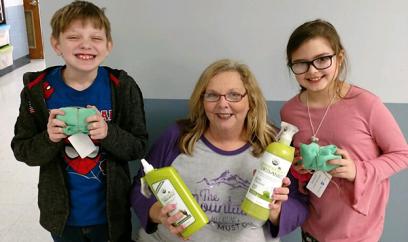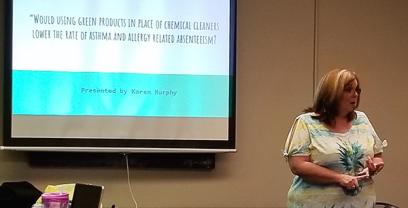Head custodian Karen Murphy was worried. A little boy at her school was suffering greatly from asthma. “It would bother him so bad,” she says. Plus, the flu ran rampant in some classrooms, where absences from respiratory illnesses had begun impeding teachers’ ability to keep students on the same page.
Murphy’s concern was noted, as was her record of keeping Mount Olive Elementary School sparkling clean, and her excitement whenever she returned from an AFT PSRP conference. So when Marrianne Hayward, president of the Jefferson County AFT in Birmingham, Ala., selected Murphy to take part in the AFT Teacher Leaders Program, it seemed like a perfect opportunity. Murphy became one of the few PSRP (paraprofessionals and school-related personnel) members around the country to join the Teacher Leaders Program, and says that without the program, “it would have never crossed my mind” to start such an ambitious undertaking.
“I thought, ‘What can I do in my school that I could research?’” says Murphy, who also has worked as a paraprofessional and a preschool teacher at Mount Olive, and knows every inch of the school. “I started wondering about the aerosol cleaning products we were using.”
She began researching green cleaning in schools. In 2013, the latest year for which data is available, the Centers for Disease Control and Prevention says 13.8 million school days were reported missed by children with asthma. High-poverty schools also have the highest number of students with asthma.
Research in hand, Murphy enlisted the school nurse and the new principal, who were “100 percent on board.” Over three months, Murphy conducted an experiment in six classrooms where absenteeism ran higher than in the rest of the school. Three classrooms were cleaned with conventional products, including the standard bleach and aerosols she’d used for years, and three other classrooms with green cleaners such as baking soda. She measured incidents of asthma and flu, as well as absences. Although admittedly unscientific, her experiment made a difference. “It was a success,” Murphy says, “and it really motivated me.”
Now she’s taking the whole school green. She’ll finish up the old cleaners because her school doesn’t have a big budget—not that there’s much difference in cost. She’s introducing plants and lowering thermostats. With help from the union, she’ll use microfiber cloths.
“You need to stop and think about what you’re doing because in the long run, it can be detrimental to your health,” Murphy says. “Be very cautious about what you’re using in your classrooms, in your janitorial closet, in your homes. This is our earth and these kids are our future. We need to protect their lungs.”
Michael Lohman, a health and safety specialist for the AFT who conducts train-the-trainer programs at our affiliates nationwide, notes that green cleaning products are associated with fewer absences and are firmly linked with fewer asthma attacks, respiratory issues and allergies. “Everywhere I go,” he says, “the number of kids who are asthmatic is growing.”
When he trains members in green cleaning, Lohman says many of them are surprised that room fragrance plug-ins and “regular” cleaning products actually pose a hazard to pregnant women. He also cites research showing that women working in education have more respiratory issues than women in the general workforce. He teaches members how to read labels for environmentally preferred products (such as Green Seal and EcoLogo), how to use Material Safety Data Sheets and how to avoid misleading claims on cleaning products.
AFT organizer Sheila Jones looks forward to more training among JCAFT members: “Overall, I think it’s such a huge plus for the AFT to come in with so many resources they can use.”
Next, just as she led the charge for green cleaning among teachers, Murphy plans to spread the word among parents, telling them how green cleaning products are helping their kids at school and encouraging them to do the same at home. She hopes to have teachers sign a pledge card to “go green,” then provide them with starter kits. And because the school’s lunchroom workers were not in the initial workshop because they had other training that day, Murphy wants to bring them up to speed. Finally, she wants to share her results with local media.
“For any school to become greener,” Murphy says, “there are a few factors to keep in mind. First, it’s important to build a team of allies, starting with your union. Second, make sure people understand the difference between ‘regular’ and green cleaning products. Third, engage decision-makers. If you can sway people to what a difference this can make in the safety and happiness of children, it will make the transition easier.”
[Annette Licitra]


